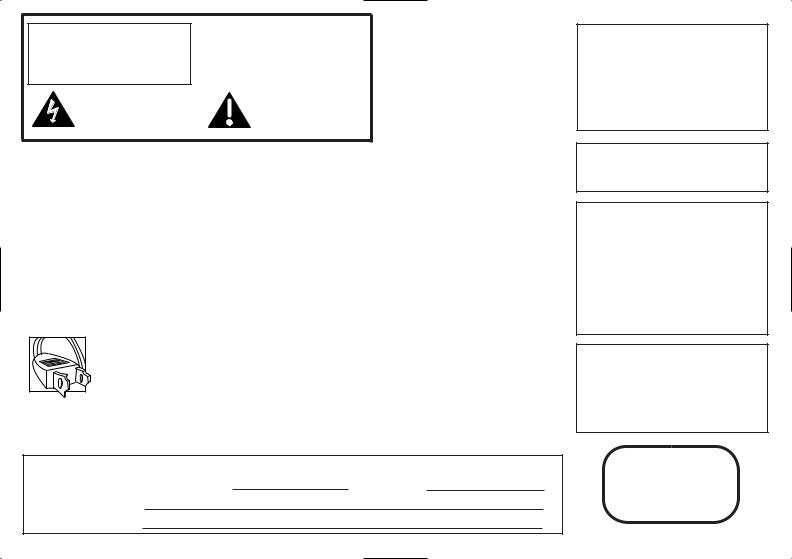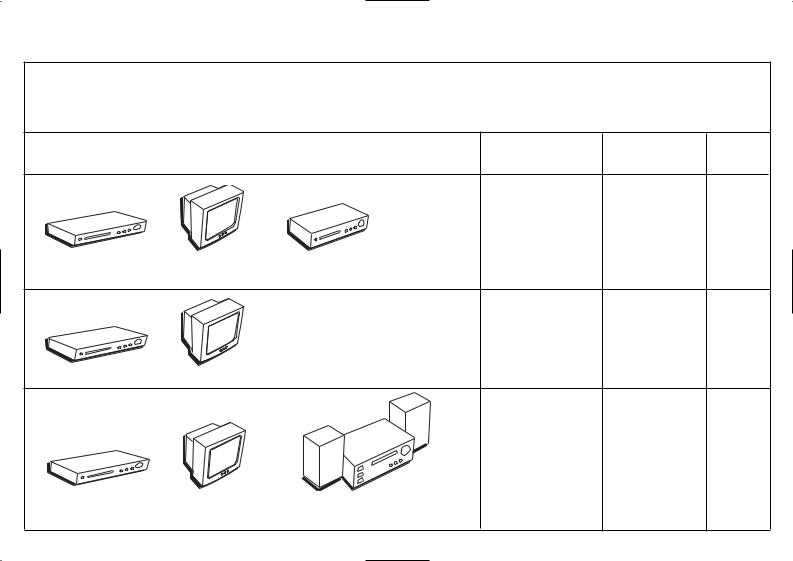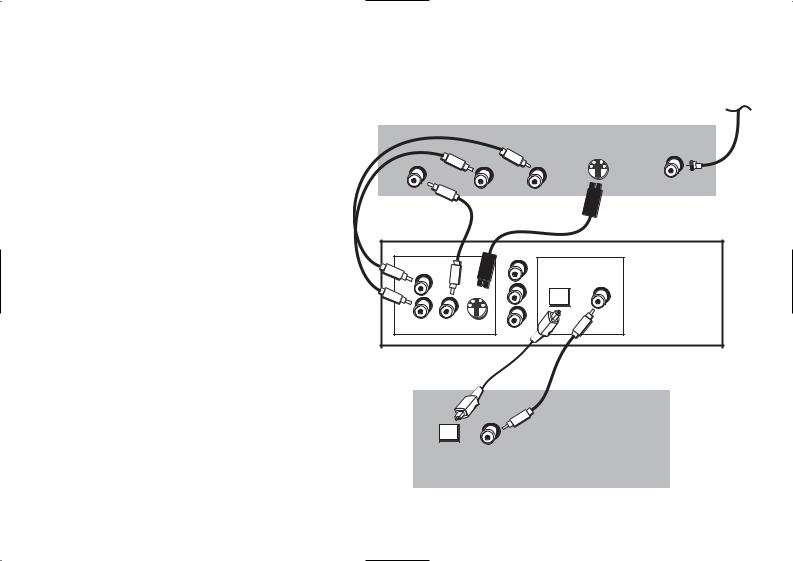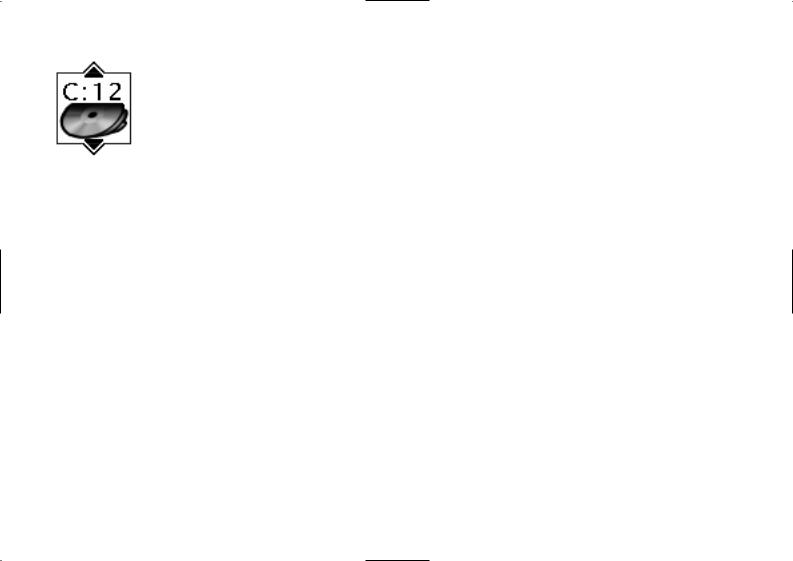RCA DRC220N User Manual

DVD Player User’s Guide
Changing entertainment. Again.
DRC220N

WARNING
RISK OF ELECTRIC SHOCK.
DO NOT OPEN.
This symbol indicates “dangerous voltage” inside the product that presents a risk of electric shock or
FCC INFORMATION
To reduce risk of electrical shock, do not remove cover or back (no user serviceable parts inside). Refer servicing to qualified personnel.
This symbol indicates important instructions accompanying the product
WARNING To reduce the risk of fire or shock hazard, do not expose this DVD player to rain or moisture. No objects filled with liquids, such as vases, shall be placed on the apparatus.
This equipment has been tested and found to comply with the limits for a Class B digital device, pursuant to Part 15 of the FCC rules. These limits are designed to provide reasonable protection against harmful interference in a residential installation. This equipment generates, uses and can radiate radio frequency energy and, if not installed and used in accordance with the instructions, may cause harmful interference to radio communications. However, there is no guarantee that interference will not occur in a particular installation. If this equipment does cause harmful interference to radio or television reception, which can be determined by turning the equipment off and on, the user is encouraged to try to correct the interference by one or more of the following measures.
•Reorient or relocate the receiving antenna.
•Increase the separation between the equipment and receiver.
•Connect this equipment into an outlet on a circuit different from that to which the receiver is connected.
•Consult the dealer or an experienced radio/TV technician for help.
This class B digital apparatus meets all requirements of the Canadian Interference--Causing Equipment Regulations.
Refer to the identification/rating label located on the back panel of your product for its proper operating voltage.
Caution: To prevent electric shock, match wide blade of plug towide slot, fully insert.
Attention: Pour éviter les chocs électriques, introduire la lame la plus large de la fiche dans la borne
Product Registration: Please fill out the product registration card packed with this product, and return it. immediately Returning this card enables us to contact you if necessary.
Keep your sales receipt to obtain warranty parts and service and for proof of purchase. Attach it here and record the serial andmodel numbers in case you need them. The numbers are located on the back of the player.
Model number: DRC220N Serial Number: Purchase date: Dealer address and phone:
CAUTION
THIS PRODUCT UTILIZES A LASER. USE OF CONTROLS OR ADJUSTMENTS OR PERFORMANCE OF PROCEDURES OTHER THAN THOSE SPECIFIED HEREIN MAY RESULT IN HAZARDOUS RADIATION EXPOSURE. DO NOT OPEN COVERS AND DO NOT REPAIR YOURSELF. REFER SERVICING TO QUALIFIED PERSONNEL.
CAUTION
FCC Regulations state that unauthorized changes or modifications to this equipment may void the user’s authority to operate it.
Note:
This device is protected by U.S. patent numbers 4,631,603 and 4,577,216 and 4,819,098 and other intellectual property rights. The use of Macrovision’s copy protection technology in the device must be authorized by Macrovision and is intended for home and other limited pay-per-view uses only, unless otherwise authorized in writing by Macrovision. Reverse engineering or disassembly is prohibited
This DVD player is designed and manufactured to respond to the Region Management Information. If the Region number of a DVD disc does not correspond to the Region number of this DVD player, this DVD player cannot play the disc. The Region number for this DVD player is Region No 1.
CLASS 1
LASER
PRODUCT

Table of Contents |
|
Chapter 1: Setup and Connections |
|
Things to consider before you connect .................................................................................... |
2 |
Choose your connection.............................................................................................................. |
3 |
Connection: DVD + TV + VCR.......................................................................................... |
4 |
Connection: DVD + TV .................................................................................................... |
5 |
Connection: DVD + TV + Audio Receiver ...................................................................... |
6 |
Install batteries in the remote control ...................................................................................... |
8 |
Turn on the TV and the DVD player .......................................................................................... |
8 |
Chapter 2: The Remote Control................................ |
10 |
Explanation of the buttons ...................................................................................................... |
10 |
Find out if the remote can operate your TV .......................................................................... |
13 |
Chapter 3: Playing Discs .......................................... |
14 |
Regional Coding ........................................................................................................................ |
14 |
Using Different Menus.............................................................................................................. |
14 |
How to Load and Play Discs .................................................................................................... |
15 |
Search Options .......................................................................................................................... |
16 |
Playback Options ...................................................................................................................... |
16 |
Using the On-Screen Info Display .......................................................................................... |
17 |
Time Display .................................................................................................................... |
18 |
Selecting a Title .............................................................................................................. |
18 |
Selecting a Chapter ........................................................................................................ |
19 |
Selecting Subtitles .......................................................................................................... |
20 |
Changing the Audio Language ...................................................................................... |
21 |
Using the Repeat Feature .............................................................................................. |
22 |
Using the Power-On Bookmark Feature ...................................................................... |
23 |
Changing the Camera Angle.......................................................................................... |
25 |
Playing Audio CDs .................................................................................................................... |
26 |
Playing Video CDs (VCDs) ........................................................................................................ |
29 |
Playing MP3 Discs .................................................................................................................... |
30 |
Viewing JPEG files .................................................................................................................... |
32 |
Chapter 4: DVD Menu System |
|
General Explanation of the Menu System .............................................................................. |
33 |
Play Mode menu........................................................................................................................ |
34 |
Standard Play .................................................................................................................. |
34 |
Random Play .................................................................................................................. |
34 |
Program Play .................................................................................................................. |
35 |
Edit Program .................................................................................................................. |
35 |
AutoPlay .......................................................................................................................... |
35 |
Lock menu.................................................................................................................................. |
36 |
Locking Player ................................................................................................................ |
36 |
Unlocking Player ............................................................................................................ |
37 |
Changing Your Password ................................................................................................ |
37 |
Setting Ratings Limits (parental control) .................................................................... |
38 |
Display menu ............................................................................................................................ |
40 |
TV Image.......................................................................................................................... |
40 |
Front Display .................................................................................................................. |
42 |
Sound menu .............................................................................................................................. |
43 |
Sound Logic .................................................................................................................... |
43 |
Digital Output ................................................................................................................ |
44 |
Virtual Surround ............................................................................................................ |
44 |
Languages menu........................................................................................................................ |
45 |
Player Menus .................................................................................................................. |
45 |
Disc Menus ...................................................................................................................... |
45 |
Audio .............................................................................................................................. |
46 |
Subtitles .......................................................................................................................... |
47 |
Chapter 5: Additional Information |
|
Troubleshooting ........................................................................................................................ |
48 |
Handling Cautions .................................................................................................................... |
52 |
Back of the DVD Player (explanation of jacks) ...................................................................... |
54 |
Front of the DVD Player (explanation of buttons and controls) .......................................... |
55 |
Explanation of Input Jacks and Cables .................................................................................. |
56 |
Limited Warranty ...................................................................................................................... |
58 |
How to find your TV’s Video Input Channel .......................................................................... |
61 |
Accessories ................................................................................................................................ |
62 |
Index .......................................................................................................................................... |
63 |

Chapter 1: Setup and Connections
Things to consider before you connect
Protect components from overheating
•Don’t block ventilation holes on any of the components. Arrange the components so that air can circulate freely.
•Don’t stack components.
•When you place components in a stand, make sure you allow adequate ventilation.
•If you connect an audio receiver or amplifier, place it on the top shelf.
Position cables properly to avoid audio interference
•Insert each cable firmly into the designated jack.
•If you place components above the TV, route all cables down the side of the back of the TV instead of straight down the middle of the back of the TV.
•If your antenna uses 300-ohm twin lead cables, do not coil the cables. Also, keep the twin lead cables away from audio/video cables.
Connection Pictures
Audio/video cables are usually bundled together. For better visibility, the connection pictures in this book show each cable separately (audio left, audio right, and video). Graphics contained within this publication are for representation only.
VIDEO CD
Some discs may not be compatible due to laser pickup and disc design.
Types of discs your DVD player can play
•DVD discs – contian picture and sound (DVD-R, DVD+RW are compatible with this player) .
•CDs (CD-R, CD-RW) – Audio CDs contain musical or sound content only. MP3 discs are CDs that contain MP3 files. This player is also capable of playing CDs that contain JPEG files.
•Video CD discs – Like DVD video discs, Video CDs contain picture and sound content. The difference is the amount of information that can be stored on the disc. VCDs typically have lower picture and sound quality than DVD discs.
2

Chapter 1: Setup and Connections
Choose Your Connection
There are several ways to connect your DVD player. Please use the following chart to determine which connection is best for you. Turn to the appropriate page, and connect your DVD Player.
|
Components |
Cables Needed |
Connection |
Go to... |
|
|
|
Title |
|
|
|
• Coaxial |
DVD + TV + VCR |
4 |
|
|
• Audio/video |
|
|
|
|
• S-Video (optional) |
|
|
DVD |
TV |
VCR |
|
|
|
|
• Coaxial |
DVD + TV |
5 |
|
|
• Audio/video |
|
|
|
|
• S-Video (optional) |
|
|
DVD |
TV |
|
|
|
|
|
• Coaxial |
DVD + TV + |
6 |
|
|
• Audio/video |
Audio Receiver |
|
|
|
• S-Video (optional) |
|
|
DVD |
TV |
Audio Receiver |
|
|
3

Chapter 1: Setup and Connections
Back of TV (example)
|
VIDEO |
L |
AUDIO |
R |
S-VIDEO |
CABLE/ANTENNA |
4 |
|
|
|
|
|
|
||||
|
|
|
|
|
|
|||
|
2a |
- OR - |
2b |
|
|
|
||
|
AUDIO |
|
|
|
|
|
|
|
|
OUT |
|
Y |
DIGITAL AUDIO OUT |
|
|
|
|
|
|
|
|
|
|
|||
|
R |
S-VIDEO |
|
|
|
|
|
|
1 |
OUT |
Pb |
|
|
|
|
|
|
|
|
|
|
|
|
|
||
L |
|
Pr |
|
|
|
|
|
|
|
|
|
|
OPTICAL |
COAXIAL |
|
|
|
|
|
|
VIDEO OUT |
|
|
|
|
|
Back of DVD Player |
|
|
|
|
4 |
|
||
|
|
|
AUDIO |
|
OUT TO TV |
|
||
|
VIDEO |
|
|
|
|
|
|
|
|
|
L |
R |
|
|
|
CABLE |
|
|
|
|
|
|
|
|
|
OR |
|
|
|
|
|
|
|
OFF-AIR SIGNAL |
|
|
|
|
|
|
IN FROM ANTENNA |
|
|
|
|
Back of VCR (example) |
|
|
|
3 |
|
||
The back of your TV and VCR might look different than the ones pictured here.
Details about the different kinds of cables used to connect your DVD player are on page 56.
Connection: DVD + TV + VCR
1.Connect the audio cables to the AUDIO OUT L (left – white) and R (right
– red) jacks on the back of your DVD Player, and to the corresponding Audio Input jacks on your TV (sometimes labeled AUDIO IN L and R).
2.Connect the video cable.
A.Basic video connection – Connect the video cable (yellow) to the VIDEO OUT jack on the back of your DVD Player, and to the Video Input jack on your TV (sometimes labeled VIDEO IN).
–OR –
B.S-Video (optional) – If your TV has an S-Video jack, connect the S-Video cable (not provided) to an S-VIDEO OUT jack on the back of your DVD Player and to the S-VIDEO jack on your TV.
Note: If your TV has component video (Y, Pb, Pr) jacks, use video-grade cables (not provided) to connect the TV to the DVD player (Y to Y, Pb to Pb, etc.). It is essential to match the color coded connectors with a compatible TV.
3.Connect the antenna or cable to the Antenna Input jack on the VCR (sometimes labeled IN FROM ANTENNA).
4.Connect a coaxial cable to the Antenna Output jack on the VCR (OUT TO TV) and to the Antenna Input jack (CABLE/ANTENNA) on the TV.
5.Insert the AC power cord into an AC outlet.
Note: Don’t connect the DVD player to the VCR, or through the VCR. Doing so could negatively affect the picture quality and/or disable the DVD player.
Go to page 8
4

Back of TV (example)
VIDEO |
AUDIO |
S-VIDEO |
CABLE/ANTENNA |
L |
R |
|
- OR -
AUDIO |
|
|
|
|
OUT |
|
Y |
DIGITAL AUDIO OUT |
|
|
|
|||
R |
S-VIDEO |
|
|
|
OUT |
Pb |
|
|
|
|
|
|
|
|
L |
|
|
OPTICAL |
COAXIAL |
|
|
Pr |
||
|
|
|
|
|
VIDEO OUT
Back of DVD Player
The back of your TV and VCR might look different than the ones pictured here.
Details about the different kinds of cables used to connect your DVD player are on page 56.
Chapter 1: Setup and Connections
Connection: DVD + TV
CABLE
OR
OFF-AIR SIGNAL 1. Connect the audio cables to the AUDIO OUT L (left – white) and R (right – red) jacks on the back of your DVD Player, and to the corresponding Audio Input jacks on your TV (sometimes labeled AUDIO IN
L and R).
2.Connect the video cable.
A.Basic video connection – Connect the video cable (yellow) to the VIDEO OUT jack on the back of your DVD Player, and to the Video Input jack on your TV (sometimes labeled VIDEO IN).
–OR –
B.S-Video (optional) – If your TV has an S-Video jack, connect an S-Video cable (not provided) to the S-VIDEO OUT
jack on the back of your DVD Player and to the S-VIDEO jack on your TV.
Note: If your TV has component video (Y, Pb, Pr) jacks, use videograde cables (not provided) to connect the TV to the DVD player (Y to Y, Pb to Pb, etc.). It is essential to match the color coded connectors with a compatible TV.
3. Connect the AC power cord into an AC outlet.
4. Connect your cable or off-air antenna to your television as you normally would. You may need to consult your television manual for details.
Go to page 8
5

Chapter 1: Setup and Connections
Connection: DVD + TV + Audio Receiver
Both Dolby Digital® and DTS® are audio formats used to record 5.1-channel audio signals onto the digital track of film (while the film is being made). Both of these formats provide up to six separate channels: left, right, center, left rear, right rear, and common subwoofer. The disc will play 5.1-channel sound only if you’ve connected a DTS or Dolby Digital receiver or decoder and if the disc is encoded in the Dolby Digital or DTS format.
Please Read This Before Using the DIGITAL AUDIO OUT Jack!
This player’s digital output jack is designed for a connection to a Dolby Digital or DTS receiver or decoder. Older digital equipment may not be compatible with the Dolby Digital bitstream. Such a connection can create a high level of noise that may be harmful to your ears, and could damage headphones or speakers. It is important to choose the correct Digital Output setting in the DVD Player’s Sound menu, especially when you use either of the DIGITAL AUDIO OUT jack. For more information, go to page X.
Manufactured under license from Dolby Laboratories. “Dolby” and the double-D symbol are trademarks of Dolby Laboratories. Confidential unpublished works. © 1992-1997 Dolby Laboratories, Inc. All rights reserved.
DTS is a registered trademark of Digital Home Theater Systems, Inc.
CABLE
OR
OFF-AIR SIGNAL
Back of TV (example)
VIDEO |
AUDIO |
S-VIDEO |
CABLE/ANTENNA |
L |
R |
|
AUDIO |
|
|
|
OUT |
|
Y |
DIGITAL AUDIO OUT |
|
|
||
R |
S-VIDEO |
|
|
OUT |
Pb |
|
|
|
|
|
|
L |
|
|
COAXIAL |
|
|
Pr |
|
|
|
|
VIDEO
Back of DVD Player
|
|
Consult the |
|
|
|
manual that |
|
|
|
came with |
|
OPTICAL |
COAXIAL |
your receiver |
|
to connect it |
|||
|
|
||
|
|
completely. |
Back of Receiver (example)
6

Chapter 1: Setup and Connections
DVD Player + TV + Audio Receiver
1.Connect the left and right audio cables to your audio/video receiver and to the AUDIO OUT L (left – white) and R (right – red) jacks on the back of your DVD Player.
2.If you have a Dolby Digital or DTS receiver, use one of the DIGITAL AUDIO OUT jacks to connect the receiver to the DVD player. You must also set the Digital Output setting in the Sound menu (go to page 44).
Note: The DIGITAL AUDIO OUT jack has two options: OPTICAL and COAXIAL. Some Dolby Digital receivers have one type of Digital Audio Input jack, and some have both. Under most conditions, optical and coaxial connections work equally well — the only difference is the type of cable you connect to the jack.
Rarely, but sometimes, coaxial cables — especially long ones, pick up radio frequency (RF) interference from household appliances, nearby power lines, and/or broadcast towers. If you want to use a less expensive cable, connect a coaxial cable to the COAXIAL jack.
If you would rather use the OPTICAL jack, connect an optical digital cable to the DVD player and to the corresponding digital optical input jack on the receiver.
3.Connect the video cable.
A.Basic video connection – Connect the video cable (yellow) to the VIDEO OUT jack on the back of your DVD Player, and to the Video Input jack on your TV (sometimes labeled VIDEO IN).
–OR –
B.S-Video (not provided) – If your TV has an S-Video jack, connect the S-Video cable to the
S-VIDEO OUT jack on the back of your DVD Player and to the S-VIDEO jack on your TV.
Note: If your TV has component video (Y, Pb, Pr) jacks, use video-grade cables (not provided) to connect the TV to the DVD player (Y to Y, Pb to Pb, etc.). It is essential to match the color coded connectors with a compatible TV.
4. Connect the AC power cord into an AC outlet.
Go to page 8
7

Chapter 1: Setup and Connections
Install Batteries in the Remote
1.Remove the battery compartment cover on the back of the remote.
2.Insert new batteries. Match the polarities (+ and –) on the batteries with the diagram on the remote.
3.Put the battery compartment cover back on the remote.
Important Battery Information
•If you’re not going to use the remote for a month or more, be sure to remove the batteries because they can leak and cause damage.
•Dispose of batteries in the proper manner, according to federal, state, and local regulations.
•Any battery may leak electrolyte if mixed with a different battery type, if inserted incorrectly, if all batteries are not replaced at the same time, if disposed of in fire, or if an attempt is made to charge a battery not intended to be recharged.
•Discard leaky batteries immediately. Leaking batteries can cause skin burns or other personal injury.
Point the Remote in the Right Direction and Put it in DVD Mode
When you want the remote to operate the DVD Player, point the remote at the DVD Player, not the TV. The remote has to be pointed in the correct direction and toward the correct component in order for the remote control’s signal to communicate with the sensor on the component. Make sure there is a clear path between the remote control and the component you want to operate, so the signal isn’t blocked.
Make sure the remote is in DVD mode — press the DVD button.
Turn on the TV and DVD Player
1.Turn on your TV and tune it to the correct Video Input Channel (if you don’t know which channel is your the Video Input channel, go to page 61 for help).
2.Press the ON•OFF button to turn on the DVD Player.
8

Chapter 1: Setup and Connections
3.The first time you turn on your DVD player, the Language menu appears.
If you want the DVD player’s menus to appear in English, press the OK button on the remote control. If you prefer another language, press the arrow down button until that language is highlighted. Press OK to select the language.
|
DVD TV |
ON•OFF |
Up arrow button |
|
|
SUBTITLE INFO |
GUIDE |
||
|
AUDIO |
ANGLE |
|
|
|
GO BACK |
MENU |
Right arrow |
|
|
|
|
button |
|
Left arrow |
VOL |
CH |
OK button |
|
button |
||||
MUTE |
|
|
||
Down arrow |
|
CLEAR |
|
|
|
ZOOM |
|
||
button |
|
AGAIN |
|
|
|
INPUT |
|
|
|
|
PLAY |
FORWARD |
|
|
|
REVERSE |
|
||
|
RECORD |
PAUSE |
|
|
|
STOP |
|
|
OPEN•CLOSE
Use the the arrow buttons on the remote to move through on-screen menus. Press the OK button to select a menu item that is highlighted.
Next Steps
This chapter is dedicated to connecting your DVD Player. Before you start playing discs, you might want to get familiar with the remote control — Chapter 2 has details.
If you want to skip straight to playing discs, go to Chapter 3 (page 14). It explains playback features of DVDs, Audio CDs, Video CDs, discs that contain MP3 files, and discs that contain JPEG files.
The DVD Player’s menu system is outlined in Chapter 4 (page 33), and Chapter 5 contains troubleshooting assistance, your Limited Warranty, and additional information about your DVD Player.
9

Chapter 2: The Remote Control
The Remote Control
DVD TV |
ON•OFF |
SUBTITLE INFO |
GUIDE |
AUDIO |
ANGLE |
GO BACK |
MENU |
VOL |
CH |
MUTE |
|
|
CLEAR |
|
ZOOM |
|
AGAIN |
INPUT |
|
PLAY |
FORWARD |
REVERSE |
|
RECORD |
PAUSE |
STOP |
|
OPEN•CLOSE
This remote operates most RCA, GE, and Proscan TVs.
You can use this remote to operate the DVD player, and to access the features available. The remote is also designed to operate most RCA, GE, and Proscan TVs — just press the TV button. The descriptions that follow, describe how each button works when operating the DVD player.
0-9 (Number buttons) Use the number buttons to input information such as chapter numbers, track numbers, or to make selections on some menu screens.
Arrow buttons (up, down, left, right) Use the arrow buttons to move through the on-screen menu system and Info Display.
AGAIN Accesses the Scene Again™ feature — replays the last several seconds of the title you’re playing.
ANGLE Accesses various camera angles that might have been added to the disc when it was created.
Note: Currently, very few movies provide multiple camera angles.
AUDIO Accesses the audio portion of the on-screen Info Display that enables you to play a disc in a different language (the feature only works if the disc was created with different audio languages).
10

Chapter 2: The Remote Control
CH + Advances to the next chapter or track.
CH – Goes back to the preceding chapter or track.
CLEAR Removes on-screen menus and displays.
DVD Puts the remote in DVD mode so it operates the DVD Player.
FORWARD Searches forward through the disc.
GO BACK Returns you to the previous menu.
GUIDE Accesses the DVD disc guide (if available).
INFO Displays the on-screen Info Display (for details about the Info Display, go to page X.)
INPUT No function when operating the DVD Player (DVD mode). In TV mode, accesses the Video Input Channel(s) so you can see what’s playing in the DVD Player, on the TV screen.
MENU Accesses the disc’s menu (disc guide) if one is available.
MUTE No function when operating the DVD Player (DVD mode). In TV mode, lowers the volume to its minimum level. Press again to restore volume.
OK When a menu is on the screen, selects the highlighted item.
ON•OFF Turns the DVD Player on and off.
OPEN/CLOSE Opens and closes the disc tray when you press and hold down the button for several seconds.
11

Chapter 2: The Remote Control
DVD TV |
ON•OFF |
SUBTITLE INFO |
GUIDE |
AUDIO |
ANGLE |
GO BACK |
MENU |
VOL |
CH |
MUTE |
|
|
CLEAR |
|
ZOOM |
|
AGAIN |
INPUT |
|
PLAY |
FORWARD |
REVERSE |
|
RECORD |
PAUSE |
STOP |
|
OPEN•CLOSE
This remote operates most
RCA, GE, and Proscan TVs.
PAUSE Pauses disc play. When using DVD discs, press again to search forward a frame at a time.
PLAY Begins disc play.
RECORD Used with some TVs that have an on-screen programming guide that enables automatic recording when connected to a VCR.
REVERSE Searches backward through the disc.
STOP Stops playback. Press and hold to open and close the disc tray. In order to see the DVD Player menu, press the STOP button.
SUBTITLE Accesses the Subtitle part of the on-screen Info Display, and turns Subtitles on and off (if subtitles are available on the disc you’re playing.
TV Used to operate your TV (this remote operates most models of RCA, GE, and Proscan brand TVs).
VOL +/– If your remote is capable of operating your TV, increases and decreases the volume level.
ZOOM Enlarges the image on the screen so you can zoom in on details. To pan horizontally and vertically while you’re zooming, press the arrow buttons on the remote.
12

DVD TV |
ON•OFF |
SUBTITLE INFO |
GUIDE |
AUDIO |
ANGLE |
GO BACK |
MENU |
VOL |
CH |
MUTE |
|
|
CLEAR |
|
ZOOM |
|
AGAIN |
INPUT |
|
PLAY |
FORWARD |
REVERSE |
|
RECORD |
PAUSE |
STOP |
|
OPEN•CLOSE
This remote operates most RCA, GE, and Proscan TVs.
Chapter 2: The Remote Control
Find out if the remote can operate your TV
This remote control is designed to operate most RCA, GE, and Proscan TVs.
1.Press the TV button.
2.Press the ON•OFF button (if the TV turns on or off, this remote will operate the TV).
Tune to the TV’s Input Channel
To watch DVDs, the TV needs to be tuned to the Video Input channel that corresponds with the jacks you used to connect the DVD Player to the TV.
1.Press the TV button on the remote.
2.Press the INPUT button until you see the picture from the DVD Player (the DVD main menu, or if a disc is playing, you’ll see the movie on the screen). If you need more help to find your Video Input channel, go to page 61.
13

Chapter 3: Playing Discs
VIDEO CD
This DVD Player is capable of playing the following types of discs: DVDs, audio CDs, Video CDs, MP3 CDs. Before you put a disc in the player, make sure it is compatible.
You can’t play the following types of discs:, Laserdiscs, CD-I, CD-ROM (computer-only discs), DVD-ROM, or discs recorded using other broadcast standards (i.e. PAL or SECAM).
Note: Some discs may not be compatible due to laser pickup and disc design.
Chapter Contents
The beginning of this chapter pertains to DVD discs. Many of the player’s features work the same way with other types of discs. Video CDs, Audio CDs, and MP3 CDs are explained later in the chapter.
Regional Coding
Both the DVD Player and the discs are coded by region. These regional codes must match in order for the disc to play. If the codes don’t match, the disc won’t play. This player’s code is region 1.
Using Different Menus
Each disc is programmed with different features. There are three separate types of menus that you can use to access features:
•The Disc menu – The Disc menu is part of each disc and is separate from the DVD player’s menu. The contents of each Disc menu vary according to how the disc was authored and what features are included.
The Disc menu is turned on and off (while the disc is playing) with the MENU button on the remote.
•The DVD player’s Info Display – The Info Display appears as icons across the top of the screen when a disc is playing. It can only be accessed while you are playing a disc. It’s turned on and off with the INFO button on the remote.
•The DVD player menu – The DVD player’s menu system is accessed only when a disc isn’t playing. It appears automatically when you press the STOP button on the remote.
Remember: A feature will only work if the disc was programmed with that feature. For example, if you choose subtitles on the Info Display, the subtitles will only appear if the disc was created with subtitles. If a menu or icon is “grayed out” it means that item (or feature) isn’t available.
14

|
Ca |
|
|
'tt Cattcc |
|
||
n' |
|
hh |
UU |
a |
|
|
|
C |
|
|
pp |
|
|
|
|
|
|
|
|
n example of a d disc.
|
|
d |
|
|
|
(Wi escre |
|
tc |
h |
r |
|
|
s |
||
|
|
e |
|
a |
|
|
i |
C |
n |
o |
|
t |
|
||
|
' |
|
|
n example of a d disc — the title y in the center sc.
Chapter 3: Playing Discs (DVDs)
To Load and Play a DVD Disc
Turn on the TV and your DVD Player (press ON•OFF on the remote or press the STANDBY/ON button on the DVD Player).
1.If necessary, tune the TV to its Video Input channel (if you need more information, go to page 61).
2.Press the OPEN/CLOSE button (the disc tray opens).
3.Place a disc gently into the tray with the disc’s label facing up (double-sided discs have content on both sides, so you can place either side up).
4.Press the OPEN/CLOSE or PLAY button. The disc tray closes. The DVD Player reads the disc’s table of contents, and then one of three things happens depending on how the disc was programmed:
•The disc starts playing.
•The disc menu appears on the screen. One of the options will start disc play. Highlight that option and press OK.
•The DVD Player’s main menu appears on the screen. Highlight the Play option and press OK.
When you stop playing a disc, the player remembers where you stopped. When you start playing the disc again, the DVD Player picks up where you left off unless the disc is removed or the player is unplugged, or if you press the STOP button twice.
15

Chapter 3: Playing Discs (DVDs)
Search Options
To search a disc, you can use the FORWARD button or the REVERSE button. You can also utilize the following search features:
Picture Scan — When you’re playing a disc, each time you press FORWARD or REVERSE, your DVD Player scans the disc faster until you reach the fastest scan speed. To resume normal playback, press PLAY.
Freeze Frame and Frame Advance – While a disc is playing, press PAUSE to freeze the picture. To advance one frame at a time, press PAUSE again (the on-screen icon changes from PAUSE to FRAME). Each time you press the FORWARD or REVERSE button, the picture goes to the next (or previous) frame. To resume normal playback, press PLAY.
Slow Motion (in Freeze Frame Mode) – While a disc is playing, press PAUSE. Press REVERSE or FORWARD (each time you press REVERSE or FORWARD the slow motion will get even slower until you reach slowest speed). To resume normal playback, press PLAY.
Playback options
Many of your DVD Player’s playback features are accessed through the Info Display (described on pages 17 through 25). Additionally, with some discs you can use the Zoom Feature to see details of an image and the Scene Again feature to quickly repeat the last few seconds of the movie.
Zoom
1.While you’re playing a disc, press ZOOM (the player zooms in on the image). Each time you press ZOOM, the picture is magnified even more (until you get to the maximum zoom level).
2.To see other parts of the picture when you’ve zoomed in on the image, press the up, down, left, and/or right arrow buttons.
Scene Again
1.While you’re playing a disc, press the AGAIN button on the remote (the disc automatically repeats the last few seconds of the movie).
16

Chapter 3: Playing Discs (DVDs)
Time display |
Chapter |
Audio |
Bookmark |
Title |
Subtitles |
Repeat |
Angle |
Text will appear here as you highlight different icons to help you use the Info Display.
Using the On-Screen Info Display
The on-screen Info Display contains many playback features. To see the Info Display, press the INFO button on the remote while a disc is playing (the Info Display appears across the top of the screen). Each feature is illustrated with an icon. Use the left and right arrow buttons to move through the different icons in the Info Display. When an icon is highlighted, use the up and down arrow buttons on the remote to scroll through the choices displayed in the text box under the icons.
Remember, you can only access the Info Display when you’re playing a disc. Also, the Info Display features are only available if the disc was created with that particular feature (i.e., if you select the Angle icon, you won’t be able to change the camera angle unless the disc was created with different camera angles). Also, if one of the icons is “grayed out,” the Info Display feature isn’t available for the disc you’re playing.
The invalid symbol appears on the screen when you press a button that doesn’t have any function. To make the Info Display disappear from the screen, press INFO on the remote control.
17

Chapter 3: Playing Discs (DVDs)
Hour Seconds
Minutes
Time Display
This feature displays the time that has elapsed during playback. For DVD discs, the time displayed refers to the current title and acts as a Time Search feature. For example, if you like a particular scene in a movie, you can enter the elapsed time the scene plays and skip right to it. To use Time Search:
1. Press INFO on the remote (the Info Display appears).
2.If the time box isn’t already highlighted, use the left/right arrow buttons on the remote control to highlight it.
3.Use the number buttons on the remote to enter the elapsed time you want to go to in that title. You must use two digits for each field. For example, if you enter 01:35:12, playback will start one hour, 35 minutes, and 12 seconds into the title.
Note: For Audio CDs, the time displayed refers to the track that’s playing.
Selecting a Title
Some discs contain more than one title. For example, there might be four movies on one disc (each movie might be considered a title). Each title is divided into chapters. To select a title:
1.While the disc is playing, press INFO on the remote (the Info Display appears).
2.If the Title icon on the Info Display isn’t highlighted, press the right/left arrow buttons to highlight it.
3.Use the number button(s) on the remote to enter the title number or press the up/down arrow buttons to go to the next or previous title.
Note: Some discs only have one title.
18

Chapter 3: Playing Discs (DVDs)
Selecting a Chapter
Because DVD discs use digital technology, a title can be divided into individual chapters (similar to tracks on a CD). You can skip to a specific chapter by using the Chapter feature in the Info Display.
1.While a disc is playing, press INFO on the remote (the Info Display appears).
2.Press the right arrow button until the chapter icon is highlighted.
3.Press the number button(s) on the remote to enter the chapter you want to play —enter 2 digits (for example, to go to chapter 4, press 0 and then press 4). The movie starts playing at the beginning of the chapter you entered.
Note:
The Chapter feature won’t work if the disc isn’t formatted with separate chapters.
Shortcut
While you’re playing a disc, you can use the CH +/– buttons to go to
the next chapter/previous chapter.
19
